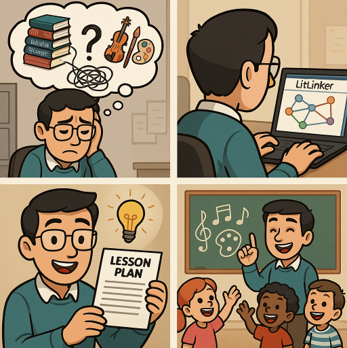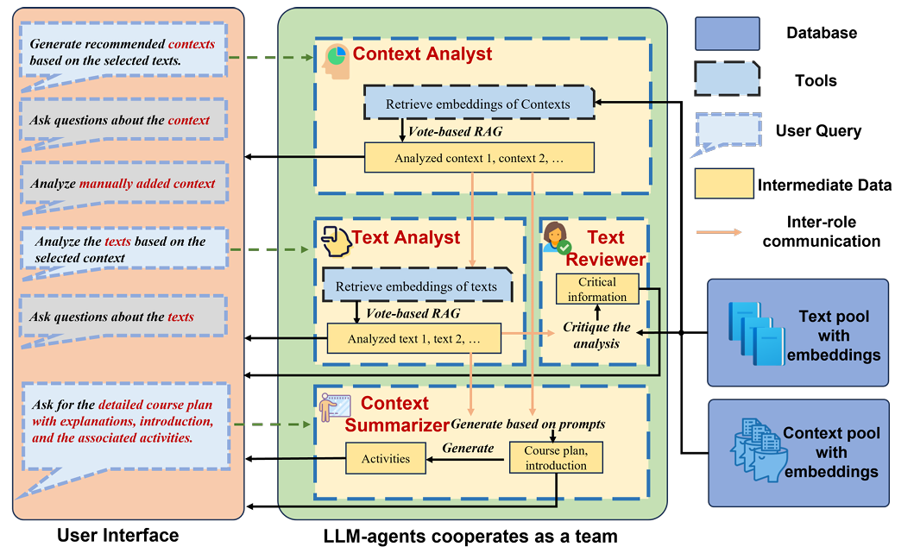- Haoxiang Fan - Sun Yat-sen University, Zhuhai, China
- Changshuang Zhou - University of Macau, Macau, China
- Hao Yu - Sun Yat-sen University, Zhuhai, China
- Xueyang Wu - NeurlStar, Shenzhen, China
- Jiangyu Gu - Xiangzhou Experimental School of Zhuhai, Zhuhai, China
- Zhenhui Peng - Sun Yat-sen University, Zhuhai, China
Abstract
Teaching literature under interdisciplinary contexts (e.g., science, art) that connect reading materials has become popular in elementary schools. However, constructing such contexts is challenging as it requires teachers to explore substantial amounts of interdisciplinary content and link it to the reading materials. In this paper, we develop LitLinker via an iterative design process involving 13 teachers to facilitate the ideation of interdisciplinary contexts for teaching literature. Powered by a large language model (LLM), LitLinker can recommend interdisciplinary topics and contextualize them with the literary elements (e.g., paragraphs, viewpoints) in the reading materials. A within-subjects study (N=16) shows that compared to an LLM chatbot, LitLinker can improve the integration depth of different subjects and reduce workload in this ideation task. Expert interviews (N=9) also demonstrate LitLinker’s usefulness for supporting the ideation of interdisciplinary contexts for teaching literature. We conclude with concerns and design considerations for supporting interdisciplinary teaching with LLMs.
Iterative Design Process
The iterative design process for LitLinker involved continuous feedback from literature teachers to refine the system. We began by conducting semi-structured interviews to understand the teachers' needs, followed by prototype development and evaluation. Teachers’ insights were incorporated at each stage, ensuring that the system effectively supported interdisciplinary context ideation. Through this iterative approach, we identified four design principles (DP1, DP2, DP3, and DP4) that guided the system’s functionality and user experience. These principles ensured that LitLinker aligns with teachers' practices and provides comprehensive support for interdisciplinary teaching.
Design Principles:
- DP1: LitLinker should provide step-by-step support aligned with teachers' habitual practices in interdisciplinary context ideation.
- DP2: LitLinker should offer detailed analysis of contexts, reading materials, and their relationships.
- DP3: LitLinker should document ideation outcomes in lesson plans aligned with established educational practices.
- DP4: LitLinker should include a database of interdisciplinary contexts and reading materials, with flexible user control for high-quality ideation outcomes.
LitLinker
User Interface
The LitLinker user interface consists of three main views: Contexts Exploration View, Texts Exploration View, and Collection View. To better understand the system's functionalities and how to navigate through these views, please refer to the demonstration video. To appeal, the video will be available after the official publication of the CHI ’25.
Architecture
The Architecture of LitLinker is designed to facilitate seamless collaboration between various system components, leveraging a multi-agent framework. It includes multiple roles, such as the Context Analyst, Text Analyst, Text Reviewer, and Context Summarizer, each responsible for specific tasks in the interdisciplinary context ideation process. These agents, powered by a large language model (LLM), interact with the user to analyze, connect, and refine the selected contexts and reading materials. The architecture ensures that each role contributes to generating high-quality interdisciplinary lesson plans by utilizing a comprehensive context database, structured prompts, and collaborative workflows. This approach enhances the overall user experience and supports effective interdisciplinary teaching.
User Study and Findings
Research Questions (RQs)
The study aimed to answer the following three research questions:
- RQ1: How would LitLinker affect the interdisciplinary context exploration outcomes?
- RQ2: How would LitLinker affect the process of interdisciplinary context exploration?
- RQ3: How would users perceive the usability and creative support provided by LitLinker?
User Study
We conducted two experiments to evaluate LitLinker. Experiment I was a within-subjects design study with 16 participants, including novices in Chinese literature teaching. Participants completed tasks using both LitLinker and a baseline system, comparing their outcomes and workload across both tools. The goal was to evaluate how LitLinker influences the ideation outcomes, process, and user perceptions of usability and creativity.
Experiment II was a qualitative study involving 9 expert teachers who provided insights into LitLinker’s usability and its effectiveness in supporting the ideation of interdisciplinary contexts in literature teaching. This experiment helped us understand how well LitLinker assisted teachers in generating interdisciplinary contexts, with an emphasis on creative ideation and practical teaching applications.
For detailed insights into the User Study and findings, please refer to our full paper.
Discussion
Design Considerations
- Encouraging teacher reflection rather than full automation: It is essential to encourage teachers to engage critically with the system's outputs and reflect on the suggestions, rather than fully relying on automation.
- Improving the diversity and suitability of informal educational context pool: A more varied and suitable collection of informal educational contexts is needed to better cater to the diverse needs of teachers.
- Meeting the expectations of different users (novice or expert): LitLinker should be adaptable to both novice and expert users, ensuring that both groups find the system useful and accessible.
Reflections on AI-Teacher Collaboration
- AI-teacher collaboration should be a continuous process: The collaboration between AI and teachers should be iterative, with teachers’ experiences contributing to enhancing AI performance, while AI-generated outputs can inspire teachers to improve the quality of their lessons.
- Ultimate responsibility for teaching decisions must remain with human educators: Despite AI's support, teachers should always retain the responsibility for making final decisions regarding teaching content and methods.
Generalizability and Future Work
- Applications in interdisciplinary teaching across different subjects and educational levels: Future applications of LitLinker could extend to various interdisciplinary teaching scenarios, covering a range of subjects and educational levels.
- Enhanced with more advanced algorithms to improve the diversity of generated contexts: Further research should explore how more advanced algorithms can enhance the diversity and relevance of the generated interdisciplinary contexts.
- Field research is needed to observe the real-world usage in the classroom with the help of AI-assisted interdisciplinary teaching: Future work should focus on field research to better understand how LitLinker is used in real classroom settings, and how AI can further support interdisciplinary teaching in practice.




